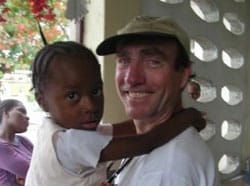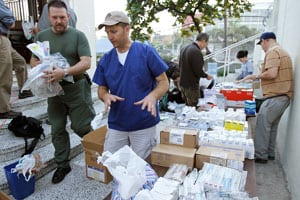Life in Haiti After the Earthquake: A Changed Perspective
Received from Ken Laura, a member of our Haiti Relief Team working in Port-au-Prince.
Sunday, April 25 — I moved last week and it has changed my situation and my perspective. Instead of sleeping in a tent beside the main road of Delmas listening to trucks roar up and down the street all night, I go to sleep seeing stars, and awaken to bird calls. Some of the birds are roosters, which start crowing at about 4:30, but other than that it is amazingly quiet here.
Whenever the power is out, usually from the morning until 10 p.m. there are very few lights in the area. Although the houses are a million dollars in size, they are only about $100,000 complete.
People do have mortgages here, but many build with the cash that they save from year to year and pay as they go. They don’t owe the bank interest, but they also have to wait a really long time to move into the house.
My new home is at the top of a steep hill in a very nice subdivision with a guard and pavement, mostly maintained. Some friends I’ve met are letting me stay as a courtesy.
Continue Reading ›Life in Haiti After the Earthquake: Weary but Resilient
This was written earlier in the week by Ken Laura, a member of our Haiti Relief Team. He has been in Port-au-Prince working with our Haitian staff since shortly after the earthquake.
 Five-thirty comes early most days, but especially on a Sunday morning when you hope to get some extra sleep before church. Not this week, however. I was wide awake at 5. I forced myself to stay in the sack for another 30 minutes despite the rooster’s consistent crowing.
Five-thirty comes early most days, but especially on a Sunday morning when you hope to get some extra sleep before church. Not this week, however. I was wide awake at 5. I forced myself to stay in the sack for another 30 minutes despite the rooster’s consistent crowing.
The high-pitched chirp of some baby doves asking for food and the soft cooing of their parents as they brought another tasty morsel to them brought back memories of 30 years ago when I was living in Limbe’ at the hospital where I worked. One of the other missionaries at that time was raising a pair of turtle doves for the eggs.
Calling my tent a sack is an exaggeration of for what I’ve been sleeping in the last three months. My tent living is nothing like what the vast majority of Port-au-Prince residents are living in at the moment.
As you’ve no doubt seen on the news, tent cities are all over town. More than 300 camps are registered in the city and more than 19 of them have 5,000-plus people living in them. The families are crammed together in muddy lots with only a sheet between them and the next family. Privacy is not a word in their vocabulary right now.
Continue Reading ›Life in Haiti After the Earthquake: It Just Hurts
Received from Scott Todd, our Senior Ministry Advisor, who is leading our medical team in Port-au-Prince.
Saturday, Jan. 30 – We had the chance to meet eight leadership students today. We sat in a circle in the parking lot listening to their stories as ashes drifted like snow upon us and the smell of burning plastics scorched the air.
They spoke of how important Compassion’s work has been in their lives. Some shared with tears about being selected for the Leadership Development Program. I don’t know whether the tears flowed from joy, gratitude or something sad.
Like the dream that almost came true. They had climbed so high. From the slums to the universities. But when we asked how many went to schools which had been damaged in the earthquake all of them raised their hands.
We asked how many had lost friends or loved ones and all raised their hands again.
At one school 90 percent (180 out of 200) of the students were killed. With buildings collapsed, professors and administrators dead, its hard to imagine how those dreams can come true now.
May God have mercy on us if we fail to find a way forward for them. They are Haiti’s future.
Life in Haiti After the Earthquake: Carrying On
From Scott Todd, our Senior Ministry Advisor, who is leading our medical team in Port-au-Prince.
I’m in my tent. Too tired to go up to the place where I can connect to Internet on the sloping desk and wobbly chair in the parking lot – so I know this won’t go out tonight.
Today (Jan. 29) we returned to the area we visited on day two. Leogone. Almost a two-hour drive. It is an absolute war zone of destruction. Nearly the whole town is rubble. I felt a deeper sadness than the other places – a community completely broken. Yet, they were clearing away the debris from the streets and already beginning to rebuild.
We arrived at the church, a partner in our program, to find a group of people under a tarp canopy. We assumed they were patients waiting for our arrival as had been the case on previous days. They weren’t.
They were the people of the church who had gathered for fasting and prayer. They sang, “What a friend we have in Jesus, all our hopes and griefs to bear.”
We set up the clinic with greater proficiency today – larger tarps, larger ropes, higher anchors so the heat radiating under the plastic didn’t bake the people (and us).
Another day of broken bones and infected wounds. A few unexpected cases – a man with polio who had fallen and needed surgery, a young boy whose foreskin was nearly sealed, preventing urination, creating back pressure and infection risk.
Half the team has suffered intestinal problems, but they carry on despite their misery. It didn’t help that there were no latrines available today. We “stood guard” for one another.
The person I will be specifically praying for tonight is Chantal. Mother of five. We saw her two days earlier and I believe it is by God’s guidance that we came to this site today.
Life in Haiti After the Earthquake: Living by Faith
Received from Scott Todd, our Senior Ministry Advisor, who is leading our medical team in Port-au-Prince.
Back at my sloping desk in the parking lot with my chair tottering over the pothole.
In some ways today (Jan. 28) was the most exhausting. Mainly the heat in our “clinic.” Once again, under tarps despite a respectable-looking church right next to us.
Our team used the church for sorting meds and eating lunch, and I hope that our occupying it might encourage the people to overcome the fear that the earth may shake it down at any moment.

Treated over 100 people again today, but the conditions generally seem less severe in the city, where people are getting access to health services.
The story that will most trouble me as I try to sleep in the parking lot again tonight is the two very young children (approximately 2 and 3 years old) whose parents both died in the quake.
These young children are registered in our Child Survival Program. Their aunt came to take them and is caring for them.
I just learned an hour ago that their aunt is 15 years old and they are sleeping in the street under a makeshift tarp tent. It’s night now and I wonder how that 15-year-old girl is going to find any food for herself or for those little ones.
I’ve only shared about the kids and people we’ve been seeing, but I want to say something about our staff in Haiti.
It just isn’t possible to describe the emotional burden they carry. I spoke with Jozue (Joshua), who works for Compassion and is pastor of the church where we set up the mobile clinic today.
Jozue told me that on the day of the quake his wife was getting ready to wash their two little girls. Their water is outside, like a backyard spigot, and when mom went out to get the water one of the girls saw her go out and began to follow. Then the second one followed.
Mom saw the girls coming out of the house and said “Get back inside.”
But the girl said “No!”
“I said go back inside!”
But the girl stomped her foot and insisted, “No!”
Life in Haiti After the Earthquake: Reclaiming Beauty From Despair
Received from Scott Todd, our Senior Ministry Advisor, who is leading our medical team in Port-au-Prince.
Today (Jan. 27) was … not sure what word could cover it. The team went to a rural site (HA748) and set up our clinic under a large mango tree.
I had to stay back in the morning because we had medical supplies that had missed the original plane and it was important to receive them. They were tagged to me, and we didn’t think U.S. forces would allow anyone else through.
So, with a tail number on an aircraft we went through the two checkpoints and were suddenly amidst the chaos of the tarmac. Massive cargo planes from the U.S. military being unloaded, vast field of materials, also some non-U.S. big planes – a 777 from Israel…. Helicopters of all types buzzing around.
We took a guess at a small plane and drove out to a field where they were parking smaller charters and we found our guy grabbed our meds and got out to HA748.
The team saw much heavier needs today. I held an 80 year old (approximately) lady for 30 minutes while she writhed in pain as our orthopedic surgeon amputated her toe. It had been crushed and was rotting infection up into the bone so it needed to be completely cleared out.
That old lady was made of leather and wire but wailed away. We probably saved her life – certainly her foot as the infection would have progressed.
Life in Haiti After the Earthquake
Received from Scott Todd, our Senior Ministry Advisor, who is leading our medical team in Port-au-Prince.
Last night’s (Jan. 25) arrival – in the dark, no lights in the airport, Humvees and Marines roaring around, bags thrown on the tarmac, smell of jet fuel, shouting, chaos, can’t find our pickup, pulling out over 30 duffel bags and boxes, driving through the chaos of Port-au-Prince with three of our guys on top of each pickup “guarding” baggage.
Touring our office at night with flashlights, framed mission statement on the wall tilted, leadership principles tilted, warning to walk clear of certain walls which are collapsing – pitch tent in parking lot, spray some DEET, take some Malarone, sweating from hauling stuff.
Today (Jan. 26), our medical team worked under tarps because the people are afraid to go inside buildings. Within an hour we were up and running and saw approximately 100 patients.
Each patient registered at entry through a gate with name, basic info including height, weight etc… and took a number. Some were triaged. Others waited to be called to one of four (sometimes five) stations. Each station had a doc, nurse and translator (though some of our Haitian nurses also served as translators).
The cases were not as severe as I expected with some very serious cuts and abrasions that were infected and needed dressing, some dislocations, a few bone issues. Many were just overwhelmed and needed someone to look at them and tell them they were okay. We prayed with some of them.


